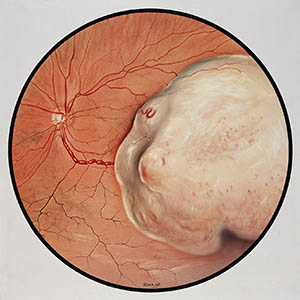
Skin cancer occurs mainly in the areas of the body that are most exposed to the sun, such as the face, neck and ears. The main symptoms are: itchy, scaly or bleeding stains.

The treatment strategy for advanced disease should aim to delay the evolution of the disease, offering patients a longer chance of survival.

The main recommendation for the prevention of skin cancer is to avoid exposure to the sun, especially at times when the sun's rays are most intense.

Melanoma skin cancer originates in the cells that produce melanin, a substance that determines skin color, and is more frequent in white adults.
It can appear anywhere on the body, on the skin or mucous membranes, in the form of spots, spots or signs. In people with black skin, it is more common in light areas, such as palms and soles.
But it is good to keep an eye! This is the most serious type, due to its high possibility of causing metastasis, that is, when the cancer goes to other organs.
In recent years, there has been a great improvement in the survival of patients with melanoma, mainly due to the early detection of the tumor and the introduction of new immunotherapeutic drugs.
Despite being very frequent, it has a high chance of cure, as long as it is detected and treated early.
Among skin tumors, non-melanoma is the most frequent and has the lowest mortality, but it can leave significant mutilations if not treated properly.
Non-melanoma skin cancer presents tumors of different types. The most frequent are:
There are still other types of skin cancer more rare that affect other cells, such as:
Anyone can develop skin cancer, but it is much more common in those who have very clear skin, albinos, with vitiligo or being treated with immunosuppressants. That’s because they are more sensitive to the sun. It is also worth remembering that skin cancer is more common in people over 40.
It is considered rare in children and black people, except people with these characteristics who have some other type of skin problem. Despite this index, the average age has been decreasing over the years, considering that young people have been constantly exposed to sunlight without the necessary protection.
That said, one of the main risk factors for developing skin cancer is prolonged exposure to the sun. However, other risk conditions for non-melanoma skin cancer are:
Signs or dots that change in size, shape or color. Wounds that do not heal within four weeks. But be aware: skin cancer varies greatly in appearance. Some may show all changes, while others may have only one or two unusual features.
So, if you notice any new sign on the skin or change in a spot or spot that already existed, it should serve as a warning to see a dermatologist.
The symmetry: Make sure both sides of a pint are equal. If there are differences, it should be investigated; Edges irregular: Make sure the edge is irregular, jagged, uneven; Color : check if there are several colors mixed in the same spot or spot; D The diameter: see if the paint or stain is growing steadily; Evolution: if the stain changes in color, size or shape. Diagnosis The diagnosis of skin cancer is made by the dermatologist through clinical examination. In certain situations, it is possible for the health professional to use the test known as dermoscopy.
This examination consists of using a device that allows you to view layers of skin not seen with the naked eye. In more specific situations it is still necessary to perform the biopsy.
Biopsy is the test indicated for the diagnostic confirmation of skin cancer. The collected material must be sent to the pathological anatomy laboratory that will issue the report. Other tests may be necessary to determine the most appropriate treatment.
Through these tests it is possible to identify whether skin cancer is melanoma or not melanoma and its types.
Surgery to remove the tumor is the most indicated treatment in cases of skin cancer, but depending on the level of the disease, it may be accompanied by radiotherapy and chemotherapy.
In addition, there is also photodynamic therapy, which consists of the use of a photosensitive cream and then an application of a light source. This treatment is more of a treatment option and is more used in superficial basal cell carcinoma, squamous cell carcinoma “in situ” (Bowen’s disease) and in actinic keratosis (precursor lesion of skin cancer).
Cryosurgery and topical immunotherapy are also options for the treatment of these cancers. However, they require precise indication by an experienced specialist. When there is metastasis, melanoma is treated with new drugs, which have high rates of therapeutic success.

Avoid sun exposure (between 10 am and 4 pm), as well as wearing sunglasses with UV protection, clothes that protect the body, wide-brimmed hats, parasols and parasol.
In case of necessary sun exposure, mainly around noon, it is recommended to look for covered areas that provide shade, such as under trees, marquees and awnings, in order to minimize the effects of solar radiation.
The use of sunscreen with sun protection factor (SPF) 30 or more is essential, especially when exposure to the sun is unavoidable. The sunscreen must be applied correctly, two to three times a day, including on the lips and on cloudy days.
Periodically examining your skin is a simple and easy way to detect skin cancer early. With the help of a mirror, you can see areas that you rarely see.
It is important to observe if there are spots that itch, peel or bleed and that cannot heal, in addition to perceiving if there are spots that have changed in size, shape or color. Early diagnosis is very important, since most cases detected at the beginning have good cure rates. Going to the dermatologist is also important.